
That doggone rotator cuff!
Here are 10 strength training exercises to AVOID if you have a sensitive rotator cuff.
If you have a painful rotator cuff, here are the 10 worst weight routines, especially with heavy loads or inadequate warmup.
These routines are likely to bring out pain in your injured or inflamed rotator cuff or worsen pain that’s continuously there.
I have done all of these weight routines, and I’ve had rotator cuff issues in the past.
Believe me, these strength training moves are notorious for causing RC problems as well as aggravating existing rotator cuff pain.
Though some people may find a few of these actually friendly to their compromised rotator cuff, the general rule is that these 10 exercises are not very friendly to the RC muscles and their tendons.
“The rotator cuff muscles are not large muscles, but there is a group of four of them that provide stability to the shoulder with moving the shoulder and gripping objects to carry them,” says Dr. Megan McLain, PT, DPT, co-founder of Intuitive Choice Physical Therapy & Wellness in Atlanta, GA.
“This follows that if any of the rotator cuff muscles are injured, then there is less muscle stability for the joint, which can lead to other issues like tearing of the labrum [cartilage].”
In order of bad to worst, here are the weight exercises that will make a strained rotator cuff bite back at you.
Dumbbell Shoulder Press
This means dumbbells, barbells and machines. For dumbbells and machines, use a neutral grip (palms facing each other), as this usually minimizes shoulder pain.
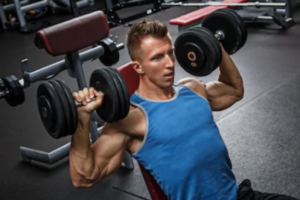
Shutterstock/BLACKDAY
Overhead Triceps Press with Dumbbell; Behind Neck Triceps Press with Cable
With one dumbbell, this presents a potential problem if the weight is heavy enough — not necessarily during the actual exercise, but getting the weight up above your head from your lap in the first place. It’s even worse bringing it down.
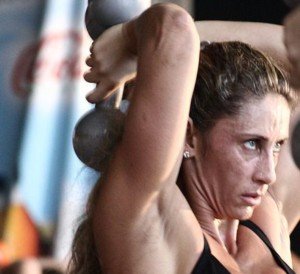
Credit: Roberto Berlim
I was using a 45-pound dumbbell (for both hands) when my shoulders were perfectly healthy, and even then, I could sense that my rotator cuff didn’t like it when I hoisted that weight from my lap to over my head, and then bringing it back down when the set was finished.
If you have rotator cuff issues, these maneuvers will bring out the pain.
A similar triceps exercise is the press-down that’s done with a cable, arms behind the neck.
“Putting the arms behind your back and then adding weight puts excess strain through the rotator cuff muscles and the ligaments of the shoulder capsule,” says Dr. McLain.
“The biggest danger here is if you lose control of the weight at all, it will pull your arms up behind your back, which if this happens suddenly, can tear or strain muscles or tendons in the anterior shoulder or under the shoulder blade.
“This exercise is most likely to compromise the pec, subscapularis or the supraspinatus, two of which are rotator cuff muscles.”
Bench Dip
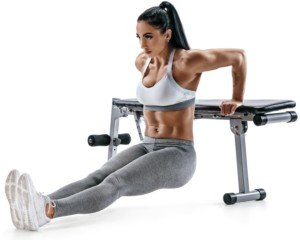
Shutterstock/RomarioIen
If you have RC pain, you may want to skip seated dips, even with bodyweight only.
Parallel Bar Dip

Shutterstock/Syda Productions
Ditto. This just won’t feel pretty if you have an inflamed rotator cuff.
Wide Grip Lat Pull-Down
These will really sting a problem rotator cuff at heavy enough weight. It’s even worse if done from behind the neck.
Oddly, when done with very, very light weight, the frontal version can be therapeutic.
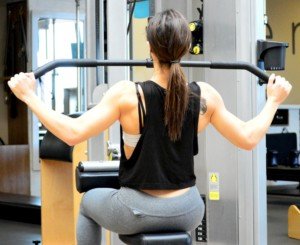
Nevertheless, even moderate weight might aggravate an injured rotator cuff.
Use a narrow grip for strength training on this apparatus.
Behind Back Military Press

Shutterstock/Artem Postoev
“Pushing a large amount of weight from a position behind the head puts excess strain through the anterior capsule of the shoulder, and can put the supraspinatus muscle in a compromising position under the acromion, which can cause fraying of the tendon,” explains Ashley Irvin, a licensed physical therapy assistant with 15+ years experience and co-founder of Intuitive Choice Physical Therapy & Wellness.
Even people with healthy shoulders shouldn’t do these. They can cause a rotator cuff injury.
Flat Bench Press
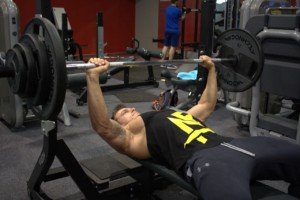
Many people who do a lot of heavy bench pressing have suffered rotator cuff pain at one point.
Anyone with rotator cuff issues will feel pain doing these, often even with light weight.
Pushup
This shouldn’t be surprising; it’s an inverted bench press. Deep pushups are even worse.
Ask a person with a painful rotator cuff what it feels like to do a pushup. They won’t even want to think about it.
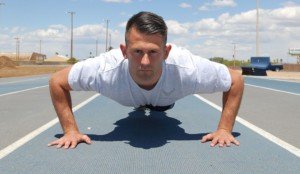
Lateral Dumbbell Raise (Side Raise)
If your arms are straight or only vaguely bent, these will kill, depending on which rotator cuff tendon is irritated.
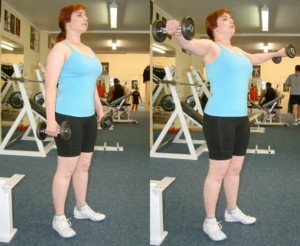
Credit: George Stepanek
The person with a bad RC won’t even be able to raise their arms (nearly straight or even slightly bent) much, sometimes even without any weights in their hands.
The more the elbow is flexed, the less pain, but if the rotator cuff is damaged enough, you won’t be able to do these even with bent arms.
“The reason this exercise can be problematic is a mismatch between the muscle’s strength and the amount of weight,” says Irvin.
“This exercise uses what’s referred to as a long lever arm for the rotator cuff tendons, meaning that the weight is far away from where the muscle is located.
“This exercise will be quite painful if someone already has a rotator cuff tear, particularly in the supraspinatus tendon.
“If you’re going to perform this exercise, start with a manageable weight and make sure that your elbows aren’t locked out, so that all of the muscles in the arm are actively helping you perform the movement.”
Upright Row
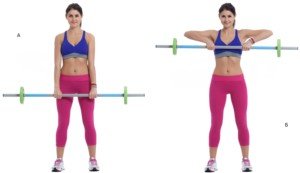
Shutterstock/Mihai Blanaru
This exercise is a major enemy to an injured rotator cuff. If your shoulder feels tweaky even in the slightest, avoid this exercise.
Cable Crossover
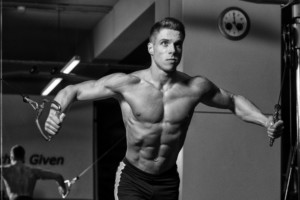
Shutterstock/Jasminko Ibrakovic
I’ve ranked this the worst because this is the routine that injured my rotator cuff the worst.
The pain was frightening when it happened — a sudden onset of acute pain during the routine — and accompanied me all day long as a strong ache that took several days to dissipate.
The result? My chest routines were squashed; most shoulder routines eliminated, along with no dipping.
It took over a year, possibly 18 months, before I had regained the strength I had before the injury.
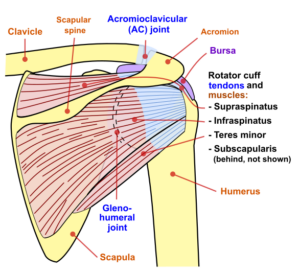
Rotator cuff muscles and tendons. Jmarchn, CC BY-SA 3.0creativecommons.org/licenses/by-sa/3.0
Honorable Mention
Pull-ups. Depending on the nature of the rotator cuff issue, pull-ups can cause problems.
“This requires you to lift your whole body by just using your shoulder muscles and arms to complete the motion,” says Dr. McLain.
“This requires a lot of generated power through your shoulder joint to be able to lift your body throughout the range that is needed to complete a pull-up.
“During part of the movement, you will have your arms almost full extended, putting more strain on your RC muscles that are the prime movers to help stabilize your shoulder.
“Because of the stability required for the movement, and the fact that the rotator cuff muscles are so important for stability, this is an exercise that should be progressed very carefully to avoid excess strain.”
Lat pull-downs are a better alternative – but make sure your grip width isn’t too wide!
Single-arm heavy ball slam to the floor. “This exercise can be problematic if you haven’t trained a throwing motion before or if you aren’t used to using a ball with a heavier weight,” says Dr. McLain.
“The quick movement and excess load of the ball in the hand can strain the rotator cuff muscles.
“If you are already used to throwing, start out with a lighter weight or slower movement to give the rotator cuff tendons time to adjust to the added load.
“As an alternative, using two hands on a med ball when performing any type of throw is the best option because this limits strain through one shoulder.”
So take it from me, these are the worst weightlifting moves for the rotator cuff, healthy or injured.
Dr. McLain puts it this way: “I would say no exercise is inherently good or bad.
“It’s typically more the length of the lever arm or the amount of weight that causes issues versus the exercise itself.
“It is all about managing the amount of load through the rotator cuff tendons.
“There are certainly exercises that are more appropriate for an individual, depending on their medical history, or that put the shoulder in a less potentially compromising position, especially if someone already has a diagnosed tear.”
 Dr. Megan McLain, PT, DPT, puts her clients first while providing one-on-one in-home care. With physical therapy and health coaching services, Dr. McLain addresses all aspects such as physical barriers, mindset, accountability and knowledge that may be impacting the client’s experience.
Dr. Megan McLain, PT, DPT, puts her clients first while providing one-on-one in-home care. With physical therapy and health coaching services, Dr. McLain addresses all aspects such as physical barriers, mindset, accountability and knowledge that may be impacting the client’s experience.
 Ashley Irvin is a licensed PTA and co-owner of Intuitive Choice Physical Therapy and Wellness. She provides holistic in-home care and addresses all factors that could be impacting her clients’ pain experience. She provides physical therapy, health coaching and personal training.
Ashley Irvin is a licensed PTA and co-owner of Intuitive Choice Physical Therapy and Wellness. She provides holistic in-home care and addresses all factors that could be impacting her clients’ pain experience. She provides physical therapy, health coaching and personal training.
 Lorra Garrick is a former personal trainer certified through the American Council on Exercise. At Bally Total Fitness she trained women and men of all ages for fat loss, muscle building, fitness and improved health.
Lorra Garrick is a former personal trainer certified through the American Council on Exercise. At Bally Total Fitness she trained women and men of all ages for fat loss, muscle building, fitness and improved health.
.
Top image: Shutterstock/KDdesignphoto
Deltoid Muscle Pain: Causes Including Cancer & Heart Problems


























